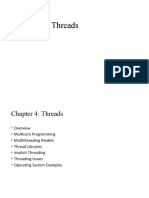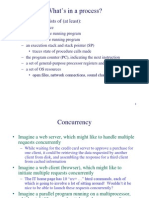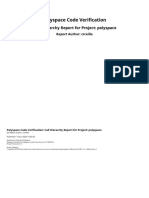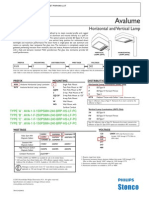Chapter 4: Threads
• Overview
• Multicore Programming
• Multithreading Models
• Thread Libraries
• Implicit Threading
• Threading Issues
• Operating System Examples
1
�Objectives
• To introduce the notion of a thread—a fundamental unit of CPU utilization that forms the basis of multithreaded
computer systems
• To discuss the APIs for the Pthreads, Windows, and Java thread libraries
• To explore several strategies that provide implicit threading
• To examine issues related to multithreaded programming
• To cover operating system support for threads in Windows and Linux
2
�Motivation
• Most modern applications are multithreaded
• Threads run within application
• Multiple tasks with the application can be implemented by separate threads
• Update display
• Fetch data
• Spell checking
• Answer a network request
• Process creation is heavy-weight while thread creation is light-weight
• Can simplify code, increase efficiency
• Kernels are generally multithreaded
3
�Multithreaded Server Architecture
4
�Single and Multithreaded Processes
5
�Benefits
• Responsiveness – may allow continued execution if part of process is blocked, especially important for user
interfaces
• Resource Sharing – threads share resources of process, easier than shared memory or message passing
• Economy – cheaper than process creation, thread switching lower overhead than context switching
• Scalability – process can take advantage of multiprocessor architectures
6
�Concurrency vs. Parallelism
• Concurrent execution on single-core system:
• Parallelism on a multi-core system:
7
�Multicore Programming (Cont.)
• Types of parallelism
• Data parallelism – distributes subsets of the same data across multiple cores, same operation on each
• Task parallelism – distributing threads across cores, each thread performing unique operation
• As # of threads grows, so does architectural support for threading
• CPUs have cores as well as hardware threads
• Consider Oracle SPARC T4 with 8 cores, and 8 hardware threads per core
8
�Amdahl’s Law
• Identifies performance gains from adding additional cores to an application that has both serial and parallel
components
• S is serial portion
• N processing cores
• That is, if application is 75% parallel / 25% serial, moving from 1 to 2 cores results in speedup of 1.6 times
• As N approaches infinity, speedup approaches 1 / S
Serial portion of an application has disproportionate effect on performance gained by adding
additional cores
• But does the law take into account contemporary multicore systems?
9
�Multicore Programming
• Multicore or multiprocessor systems putting pressure on programmers, challenges include:
• Dividing activities
• Balance
• Data splitting
• Data dependency
• Testing and debugging
• Parallelism implies a system can perform more than one task simultaneously
• Concurrency supports more than one task making progress
• Single processor / core, scheduler providing concurrency
10
�User Threads and Kernel Threads
• User threads - management done by user-level threads library
• Three primary thread libraries:
• POSIX Pthreads
• Windows threads
• Java threads
• Kernel threads - Supported by the Kernel
• Examples – virtually all general purpose operating systems, including:
• Windows
• Solaris
• Linux
• Tru64 UNIX
• Mac OS X
11
�User level threads
• Some advantages
• Compared to kernel threads, user threads can be created more quickly and are simpler to control
• We can run them on any operating system
• Thread switching doesn’t require kernel-mode privileges
• Some limitations
• The operating system kernel and threads don’t communicate well
• Regardless of whether a process contains one thread or multiple threads, it receives a single time slice during the
scheduling
• Each thread must decide when to give up control to another thread
• Non-blocking systems calls are necessary. Otherwise, even if the process still has runnable threads, it will be halted in the
kernel.
12
�Kernel threads
• Some advantages
• They permit the scheduling of many instances of the same process across various CPUs
• Multithreading is possible for kernel procedures
• When a thread is halted, the kernel can schedule another thread for the same process
• Some limitations
• They are sluggish and ineffective in contrast to user threads because the kernel must schedule and manage both
processes and threads
• Because each thread needs a whole thread control block to keep track of other threads, there is a substantial amount of
overhead
• The kernel’s complexity increases
• Transferring control from one thread in a process to another thread in the same process necessitates a mode switch to
kernel mode
13
�Multithreading Models
• Many-to-One
• One-to-One
• Many-to-Many
14
�Many-to-One
• Many user-level threads mapped to single kernel thread
• One thread blocking causes all to block
• Multiple threads may not run in parallel on muticore system because only one may be in kernel at a time
• Few systems currently use this model
• Examples:
• Solaris Green Threads
• GNU Portable Threads
15
�One-to-One
• Each user-level thread maps to kernel thread
• Creating a user-level thread creates a kernel thread
• More concurrency than many-to-one
• Number of threads per process sometimes restricted due to overhead
• Examples
• Windows
• Linux
• Solaris 9 and later
16
�Many-to-Many Model
• Allows many user level threads to be mapped to many kernel threads
• Allows the operating system to create a sufficient number of kernel threads
• Solaris prior to version 9
• Windows with the ThreadFiber package
17
�Two-level Model
• Similar to M:M, except that it allows a user thread to be bound to kernel thread
• Examples
• IRIX
• HP-UX
• Tru64 UNIX
• Solaris 8 and earlier
18
�Thread Libraries
• Thread library provides programmer with API for creating and managing threads
• Two primary ways of implementing
• Library entirely in user space
• Kernel-level library supported by the OS
19
�Implicit Threading
• Growing in popularity as numbers of threads increase, program correctness more difficult with explicit threads
• Creation and management of threads done by compilers and run-time libraries rather than programmers
• Three methods explored
• Thread Pools
• OpenMP
• Grand Central Dispatch
• Other methods include Microsoft Threading Building Blocks (TBB), java.util.concurrent package
29
�Thread Pools
• Create a number of threads in a pool where they await work
• Advantages:
• Usually slightly faster to service a request with an existing thread than create a new thread
• Allows the number of threads in the application(s) to be bound to the size of the pool
• Separating task to be performed from mechanics of creating task allows different strategies for running task
• i.e.Tasks could be scheduled to run periodically
• Windows API supports thread pools: (QueueUserWorkItem(&PoolFunction, NULL, 0))
30
�OpenMP
• Set of compiler directives and an API for C, C++, FORTRAN
• Provides support for parallel programming in shared-
memory environments
• Identifies parallel regions – blocks of code that can run in
parallel
#pragma omp parallel
Create as many threads as there are cores
#pragma omp parallel for for(i=0;i<N;i++) {
c[i] = a[i] + b[i];
}
Run for loop in parallel
31
�Grand Central Dispatch
• Apple technology for Mac OS X and iOS operating systems
• Extensions to C, C++ languages, API, and run-time library
• Allows identification of parallel sections
• Manages most of the details of threading
• Block is in “^{ }” - ˆ{ printf("I am a block"); }
• Blocks placed in dispatch queue
• Assigned to available thread in thread pool when removed from queue
32
�Grand Central Dispatch
• Two types of dispatch queues:
• serial – blocks removed in FIFO order, queue is per process, called main queue
• Programmers can create additional serial queues within program
• concurrent – removed in FIFO order but several may be removed at a time
• Three system wide queues with priorities low, default, high
33
�Threading Issues
• Semantics of fork() and exec() system calls
• Signal handling
• Synchronous and asynchronous
• Thread cancellation of target thread
• Asynchronous or deferred
• Thread-local storage
• Scheduler Activations
34
�Semantics of fork() and exec()
• Does fork()duplicate only the calling thread or all threads?
• Some UNIXes have two versions of fork
• exec() usually works as normal – replace the running process including all threads
35
�Signal Handling
• Signals are used in UNIX systems to notify a process that a particular event has occurred.
• A signal handler is used to process signals
• Signal is generated by particular event
• Signal is delivered to a process
• Signal is handled by one of two signal handlers:
• default
• user-defined
• Every signal has default handler that kernel runs when handling signal
• User-defined signal handler can override default
• For single-threaded, signal delivered to process
36
�Signal Handling (Cont.)
• Where should a signal be delivered for multi-threaded?
• Deliver the signal to the thread to which the signal applies
• Deliver the signal to every thread in the process
• Deliver the signal to certain threads in the process
• Assign a specific thread to receive all signals for the process
37
�Thread Cancellation
• Terminating a thread before it has finished
• Thread to be canceled is target thread
• Two general approaches:
• Asynchronous cancellation terminates the target thread immediately
• Deferred cancellation allows the target thread to periodically check if it should be cancelled
• Pthread code to create and cancel a thread:
38
�Thread Cancellation (Cont.)
• Invoking thread cancellation requests cancellation, but actual cancellation depends on thread state
• If thread has cancellation disabled, cancellation remains pending until thread enables it
• Default type is deferred
• Cancellation only occurs when thread reaches cancellation point
• I.e. pthread_testcancel()
• Then cleanup handler is invoked
• On Linux systems, thread cancellation is handled through signals
39
�Thread-Local Storage
• Thread-local storage (TLS) allows each thread to have its own copy of data
• Useful when you do not have control over the thread creation process (i.e., when using a thread pool)
• Different from local variables
• Local variables visible only during single function invocation
• TLS visible across function invocations
• Similar to static data
• TLS is unique to each thread
40
�Scheduler Activations
• Both M:M and Two-level models require communication to maintain
the appropriate number of kernel threads allocated to the application
• Typically use an intermediate data structure between user and kernel
threads – lightweight process (LWP)
• Appears to be a virtual processor on which process can schedule user
thread to run
• Each LWP attached to kernel thread
• How many LWPs to create?
• Scheduler activations provide upcalls - a communication mechanism
from the kernel to the upcall handler in the thread library
• This communication allows an application to maintain the correct
number kernel threads
41
�Operating System Examples
• Windows Threads
• Linux Threads
42
�Windows Threads
• Windows implements the Windows API – primary API for Win 98, Win NT, Win 2000, Win XP, and Win 7
• Implements the one-to-one mapping, kernel-level
• Each thread contains
• A thread id
• Register set representing state of processor
• Separate user and kernel stacks for when thread runs in user mode or kernel mode
• Private data storage area used by run-time libraries and dynamic link libraries (DLLs)
• The register set, stacks, and private storage area are known as the context of the thread
43
�Windows Threads (Cont.)
• The primary data structures of a thread include:
• ETHREAD (executive thread block) – includes pointer to process to which thread belongs and to KTHREAD, in kernel
space
• KTHREAD (kernel thread block) – scheduling and synchronization info, kernel-mode stack, pointer to TEB, in kernel space
• TEB (thread environment block) – thread id, user-mode stack, thread-local storage, in user space
44
�Windows Threads Data Structures
45
�Linux Threads
• Linux refers to them as tasks rather than threads
• Thread creation is done through clone() system call
• clone() allows a child task to share the address space of the parent task (process)
• Flags control behavior
• struct task_struct points to process data structures (shared or unique)
46























































































